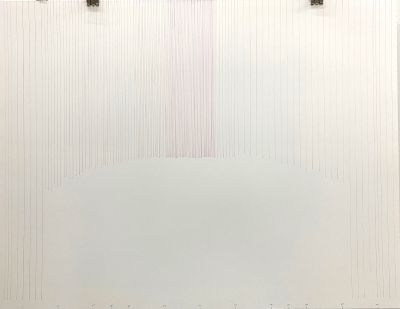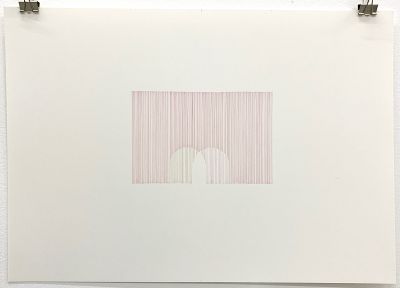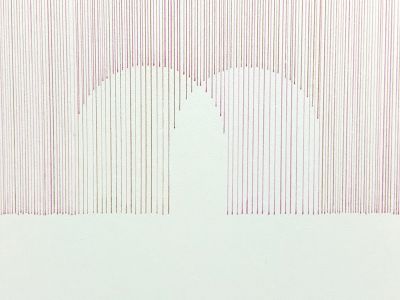No edit summary |
No edit summary |
||
| Line 6: | Line 6: | ||
And here is another drawing, ''Sounding Landshapes (Sphere) – two hypothetical readings showing movement of a sphere over time'': | And here is another drawing, ''Sounding Landshapes (Sphere) – two hypothetical readings showing movement of a sphere over time'': | ||
[[File:drawing_8408.jpeg|400px]] | [[File:drawing_8408.jpeg|400px]] | ||
Revision as of 16:57, 9 December 2020
9 DECEMBER 2020
Here's an analogue drawing I'm making using the data from my ultrasonic sensor. It takes a long time with a pen and ruler! So Max/MSP is a good solution. Here's a low-quality photo of the drawing:
And here is another drawing, Sounding Landshapes (Sphere) – two hypothetical readings showing movement of a sphere over time:
4 DECEMBER 2020
I searched around the internet for some tutorials on how to make animated drawings, and I found a really good series focused on jit.lcd. However, I still need to find out how to draw lines in a non-randomized way using my data from the ultrasonic sensor. I haven't been able to find the answer via google, I think because my question is too specific and I have a pretty clear way that I want it to look. So, feedback on how to change the objects and messages to that end would be much appreciated!
- Here is my patch: File:drawing_test_oval.maxpat
- Does this help? File:Drawing_test_line.maxpat
And here are the four tutorials that taught me how to build the patch:
Part 1: https://www.youtube.com/watch?v=QH6eAg2_2vU
Part 2: https://www.youtube.com/watch?v=5qI2CZPWr1c&t=315s
Part 3: https://www.youtube.com/watch?v=nKDP-Yo-Muk
Part 4: https://www.youtube.com/watch?v=S4jsH6JyHSY&t=15s
30 NOVEMBER 2020
Here are relevant artworks that I feel could be inspiring for this class:
Timo Arnall, Immaterials: Light painting WiFi, 2011 https://vimeo.com/20412632
Katie Paterson, As the World Turns, 2010 http://katiepaterson.org/portfolio/as-the-world-turns/
Taavi Suisalu, Distant Self-Portrait, 2016 https://taavisuisalu.xyz/@/distant-self-portrait/
File:Liz_Screen Recording 2020-11-28 at 16.07.43.mov
File:test_analogue-to-digital-to-analogue.maxpat
Here's a patch-in-progress, now that I was successfully able to get my ultrasonic sensor readings to appear in the Max console. I'm also including a screen recording of the Max print feed, so you can see what's going on – I see that the console is breaking up the lines of data into smaller pieces (which I can imagine is simple enough to fix). For example, in Max/MSP, the word "distance" is broken up between several lines, and so are the numerical figures. Here is an example of how the same data shows up in the Arduino serial plotter. Just a note, I have included the word "distance" to also be printed, just to reduce confusion about values.
15:41:05.887 -> Distance: 68.54
15:41:05.958 -> Distance: 68.54
15:41:06.063 -> Distance: 50.18
15:41:06.171 -> Distance: 50.17
15:41:06.278 -> Distance: 50.98
15:41:06.387 -> Distance: 51.39
15:41:06.459 -> Distance: 51.37
15:41:06.563 -> Distance: 50.93
15:41:06.667 -> Distance: 50.52
15:41:06.769 -> Distance: 50.52
Now that I'm thinking more of the aesthetic exploration, I would be interested to have this data converted into a digital drawing that changes over time, so I suppose that would be a video or animation. I'm particularly interested in how a drawn line in digital space can be infinitely thin (unlike a pencil line, which is defined by the material), and so I could imagine playing with what are known as "space-filling curves" that approach infinity – for example, Peano curves or Hilbert curves. Here's the wikipedia page for an overview of what's behind them:


